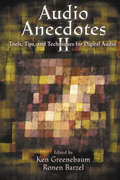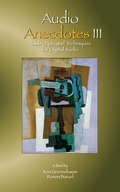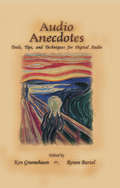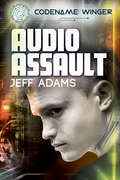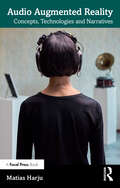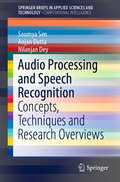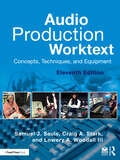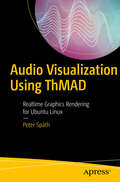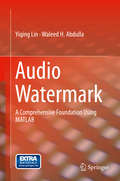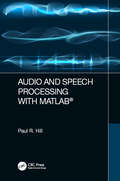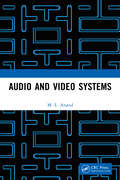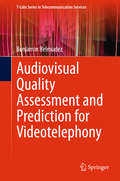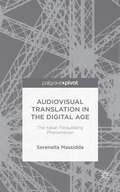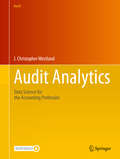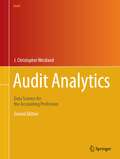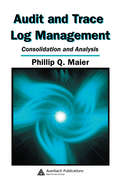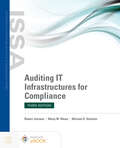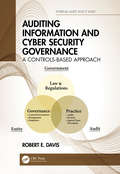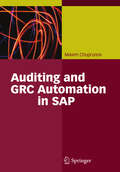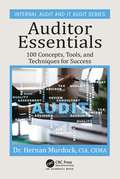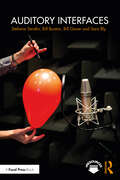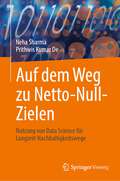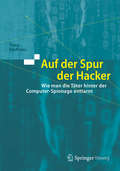- Table View
- List View
Audience of One: Donald Trump, Television And The Fracturing Of America
by James PoniewozikOne of the Top 10 Politics and Current Events Books of Fall 2019 (Publishers Weekly) An incisive cultural history that captures a fractious nation through the prism of television and the rattled mind of a celebrity president. Television has entertained America, television has ensorcelled America, and with the election of Donald J. Trump, television has conquered America. In Audience of One, New York Times chief television critic James Poniewozik traces the history of TV and mass media from the Reagan era to today, explaining how a volcanic, camera-hogging antihero merged with America’s most powerful medium to become our forty-fifth president. In the tradition of Neil Postman’s masterpiece Amusing Ourselves to Death, Audience of One shows how American media have shaped American society and politics, by interweaving two crucial stories. The first story follows the evolution of television from the three-network era of the 20th century, which joined millions of Americans in a shared monoculture, into today’s zillion-channel, Internet-atomized universe, which sliced and diced them into fractious, alienated subcultures. The second story is a cultural critique of Donald Trump, the chameleonic celebrity who courted fame, achieved a mind-meld with the media beast, and rode it to ultimate power. Braiding together these disparate threads, Poniewozik combines a cultural history of modern America with a revelatory portrait of the most public American who has ever lived. Reaching back to the 1940s, when Trump and commercial television were born, Poniewozik illustrates how Donald became “a character that wrote itself, a brand mascot that jumped off the cereal box and entered the world, a simulacrum that replaced the thing it represented.” Viscerally attuned to the media, Trump shape-shifted into a boastful tabloid playboy in the 1980s; a self-parodic sitcom fixture in the 1990s; a reality-TV “You’re Fired” machine in the 2000s; and finally, the biggest role of his career, a Fox News–obsessed, Twitter-mad, culture-warring demagogue in the White House. Poniewozik deconstructs the chaotic Age of Trump as the 24-hour TV production that it is, decoding an era when politics has become pop culture, and vice versa. Trenchant and often slyly hilarious, Audience of One is a penetrating and sobering review of the raucous, raging, farcical reality show—performed for the benefit of an insomniac, cable-news-junkie “audience of one”—that we all came to live in, whether we liked it or not.
Audio Anecdotes II: Tools, Tips, and Techniques for Digital Audio
by Ken Greenebaum Ronen BarzelThis collection of articles provides practical and relevant tools, tips, and techniques for those working in the digital audio field. Volume II, with contributions from experts in their fields, includes articles on: - Field recording - Synthesis - Signal processing - Spatialization - Computer techniques and tools - Music theory - Sound design - Sou
Audio Anecdotes III: Tools, Tips, and Techniques for Digital Audio
by Ken Greenebaum Ronen BarzelThis collection of articles provides practical and relevant tools, tips, and techniques for those working in the digital audio field. Volume III, with contributions from experts in their fields, includes articles on a variety of topics, including: - Recording Music - Sound Synthesis - Voice Synthesis - Speech Processing - Applied Signal Processing
Audio Anecdotes: Tools, Tips, and Techniques for Digital Audio
by Ken Greenebaum Ronen BarzelAudio Anecdotes is a book about digital sound. It discusses analyzing, processing, creating, and recording many forms of sound and music, emphasizing the opportunities presented by digital media made possible by the arrival of inexpensive and nearly ubiquitous digital computing equipment. Applications of digital audio techniques are indispensable i
Audio Assault. (Codename: Winger #3)
by Jeff AdamsCodename: Winger: Book ThreeFor teenage secret agent Theo Reese, summer break isn’t a time to relax. In addition to his duties for Tactical Operational Support, Theo’s got a school project and, more than anything, wants to spend time with his boyfriend, Eddie. A family trip to New York City is the last thing Theo needs. But a friend of Theo’s father is in need of the Reese family’s special skills. Oliver Glenwood heads a music empire, and his daughter, Sofia, is a rising pop star—one who’d drawn the attention of kidnappers. During the investigation, Theo discovers the threat poses more danger than originally suspected. Someone has planted code in Glenwood Music’s songs that can steal information from any personal device—or play a tone that can rouse uncontrollable rage. The consequences will be disastrous if the infected songs are downloaded by the public. Preventing worldwide catastrophe becomes even more difficult when Eddie arrives in the city, hoping to spend some quality time with Theo. No one ever said being a covert agent would be easy.
Audio Augmented Reality: Concepts, Technologies and Narratives
by Matias HarjuAudio Augmented Reality: Concepts, Technologies and Narratives provides readers with a comprehensive overview of audio augmented reality (AAR), focussing on its narrative potential while discussing several design considerations and prospective application domains.In this groundbreaking book, sound designer Matias Harju provides a practical and insightful exploration of the medium. The book draws perspectives from sound designers, researchers and industry professionals who are actively shaping this rapidly evolving field.Designed to inspire and offer practical insights, Audio Augmented Reality: Concepts, Technologies and Narratives serves as a guide for creators, academics, and anyone interested in exploring the creative potential of AAR.
Audio Processing and Speech Recognition: Concepts, Techniques and Research Overviews (SpringerBriefs in Applied Sciences and Technology)
by Soumya Sen Nilanjan Dey Anjan DuttaThis book offers an overview of audio processing, including the latest advances in the methodologies used in audio processing and speech recognition. First, it discusses the importance of audio indexing and classical information retrieval problem and presents two major indexing techniques, namely Large Vocabulary Continuous Speech Recognition (LVCSR) and Phonetic Search. It then offers brief insights into the human speech production system and its modeling, which are required to produce artificial speech. It also discusses various components of an automatic speech recognition (ASR) system. Describing the chronological developments in ASR systems, and briefly examining the statistical models used in ASR as well as the related mathematical deductions, the book summarizes a number of state-of-the-art classification techniques and their application in audio/speech classification. By providing insights into various aspects of audio/speech processing and speech recognition, this book appeals a wide audience, from researchers and postgraduate students to those new to the field.
Audio Production Worktext: Concepts, Techniques, and Equipment
by Samuel J. Sauls Craig A. Stark Lowery A. Woodall IIINow in its eleventh edition, Audio Production Worktext offers a comprehensive introduction to audio production in radio, podcasting, television, and film.This hands-on, student-friendly text demonstrates how to navigate modern radio production studios and utilize the latest equipment and software. Key chapters address production planning, the use of microphones, audio consoles, and sound production for visual media. The reader is shown the reality of audio production both within the studio and on location. In this new edition, chapters have been reorganized to address the growing prominence of podcasting and digital production. Thorough updates have been made to every chapter, including self-study questions and projects, and the authors continue to draw in diverse and international practitioner perspectives to help translate concepts to real-world practice.This book remains an essential text for audio and media production students seeking a thorough introduction to the field.The accompanying website for students and instructors has also been updated and includes sample syllabi, lesson plans, further study questions, test questions, and web resources, as well as images by chapter as included in the Worktext.
Audio Visualization Using ThMAD
by Peter SpäthLearn how to use Thinking Machine Audio Dreams (ThMAD), a realtime audio visualization engine for Ubuntu Linux. This book bridges the gap between programmers and artists. Both artists and developers with an inclination towards arts will profit from this book since it is a combination of a hands-on tutorial, manual, and reference, with many illustrations that accompany the explanations and tutorials.You'll learn the basics of ThMAD's open source software suite and then start experimenting and building your own rendering pipelines to create audio visualizations. You'll see how to soundly use all ThMAD's GUI functionalities, and all modules are provided in a way that will serve both intellectual curiosity and professional needs. The examples that are used as part of the software, and the tutorials included in the book, will serve as a solid basis for your own experiments.What You'll LearnUse the ThMAD software, all GUI functionalities, and all modulesDevelop your own audio visualization projectsExplore the program operations for ThMAD Artiste and ThMAD Player, including all possible options for controlling program operations.Who This Book Is ForVisual artists with some IT background, or developers with artistic inclinations. Development experience is not required, but surely helpful.
Audio Watermark: A Comprehensive Foundation Using MATLAB
by Yiqing Lin Waleed H. AbdullaThis book illustrates the commonly used and novel approaches of audio watermarking for copyrights protection. The author examines the theoretical and practical step by step guide to the topic of data hiding in audio signal such as music, speech, broadcast. The book covers new techniques developed by the authors are fully explained and MATLAB programs, for audio watermarking and audio quality assessments and also discusses methods for objectively predicting the perceptual quality of the watermarked audio signals. Explains the theoretical basics of the commonly used audio watermarking techniques Discusses the methods used to objectively and subjectively assess the quality of the audio signals Provides a comprehensive well tested MATLAB programs that can be used efficiently to watermark any audio media
Audio and Speech Processing with MATLAB
by Paul HillSpeech and audio processing has undergone a revolution in preceding decades that has accelerated in the last few years generating game-changing technologies such as truly successful speech recognition systems; a goal that had remained out of reach until very recently. This book gives the reader a comprehensive overview of such contemporary speech and audio processing techniques with an emphasis on practical implementations and illustrations using MATLAB code. Core concepts are firstly covered giving an introduction to the physics of audio and vibration together with their representations using complex numbers, Z transforms and frequency analysis transforms such as the FFT. Later chapters give a description of the human auditory system and the fundamentals of psychoacoustics. Insights, results, and analyses given in these chapters are subsequently used as the basis of understanding of the middle section of the book covering: wideband audio compression (MP3 audio etc.), speech recognition and speech coding. The final chapter covers musical synthesis and applications describing methods such as (and giving MATLAB examples of) AM, FM and ring modulation techniques. This chapter gives a final example of the use of time-frequency modification to implement a so-called phase vocoder for time stretching (in MATLAB). Features A comprehensive overview of contemporary speech and audio processing techniques from perceptual and physical acoustic models to a thorough background in relevant digital signal processing techniques together with an exploration of speech and audio applications. A carefully paced progression of complexity of the described methods; building, in many cases, from first principles. Speech and wideband audio coding together with a description of associated standardised codecs (e.g. MP3, AAC and GSM). Speech recognition: Feature extraction (e.g. MFCC features), Hidden Markov Models (HMMs) and deep learning techniques such as Long Short-Time Memory (LSTM) methods. Book and computer-based problems at the end of each chapter. Contains numerous real-world examples backed up by many MATLAB functions and code.
Audio and Video Systems
by M. L. AnandThis book details the important concepts in the study of audio and video systems. It covers the basics of audio and video engineering, communication and radar systems, optical fibers, and consumer electronics. It is aimed at B. Tech and Diploma students and also includes assessment questions for better understanding and practice.The subject matter of this book also discusses: Sound Synthesis Need of F.M. (Frequency Modulation) for Video Recording Turnstile Array Delta Gun Colour Picture Tube Snell’s Law Print edition not for sale in South Asia (India, Sri Lanka, Nepal, Bangladesh, Pakistan or Bhutan)
Audiovisual Quality Assessment and Prediction for Videotelephony (T-Labs Series in Telecommunication Services)
by Benjamin BelmudezThe work presented in this book focuses on modeling audiovisual quality as perceived by the users of IP-based solutions for video communication like videotelephony. It also extends the current framework for the parametric prediction of audiovisual call quality. The book addresses several aspects related to the quality perception of entire video calls, namely, the quality estimation of the single audio and video modalities in an interactive context, the audiovisual quality integration of these modalities and the temporal pooling of short sample-based quality scores to account for the perceptual quality impact of time-varying degradations.
Audiovisual Speech Processing
by Gérard Bailly Pascal Perrier Eric Vatikiotis-BatesonWhen we speak, we configure the vocal tract which shapes the visible motions of the face and the patterning of the audible speech acoustics. Similarly, we use these visible and audible behaviors to perceive speech. This book showcases a broad range of research investigating how these two types of signals are used in spoken communication, how they interact, and how they can be used to enhance the realistic synthesis and recognition of audible and visible speech. The volume begins by addressing two important questions about human audiovisual performance: how auditory and visual signals combine to access the mental lexicon and where in the brain this and related processes take place. It then turns to the production and perception of multimodal speech and how structures are coordinated within and across the two modalities. Finally, the book presents overviews and recent developments in machine-based speech recognition and synthesis of AV speech.
Audiovisual Translation in the Digital Age: The Italian Fansubbing Phenomenon
by Serenella MassiddaThis pioneering study on fan translation focuses on Italian fansubbing as a concept, a vibrant cultural and social phenomenon which is described from its inception in 2005 to today. It explores far-reaching issues related to fansubbing and crowdsourcing, highlighting in particular the benefits and drawbacks of Web 2. 0.
Audit Analytics: Data Science for the Accounting Profession (Use R!)
by J. Christopher WestlandToday, information technology plays a pivotal role in financial control and audit: most financial data is now digitally recorded and dispersed among servers, clouds and networks over which the audited firm has no control. Additionally, a firm’s data—particularly in the case of finance, software, insurance and biotech firms— comprises most of the audited value of the firm. Financial audits are critical mechanisms for ensuring the integrity of information systems and the reporting of organizational finances. They help avoid the abuses that led to passage of legislation such as the Foreign Corrupt Practices Act (1977), and the Sarbanes-Oxley Act (2002). Audit effectiveness has declined over the past two decades as auditor skillsets have failed to keep up with advances in information technology. Information and communication technology lie at the core of commerce today and are integrated in business processes around the world. This book is designed to meet the increasing need of audit professionals to understand information technology and the controls required to manage it. The material included focuses on the requirements for annual Securities and Exchange Commission audits (10-K) for listed corporations. These represent the benchmark auditing procedures for specialized audits, such as internal, governmental, and attestation audits.Using R and RStudio, the book demonstrates how to render an audit opinion that is legally and statistically defensible; analyze, extract, and manipulate accounting data; build a risk assessment matrix to inform the conduct of a cost-effective audit program; and more.
Audit Analytics: Data Science for the Accounting Profession (Use R!)
by J. Christopher WestlandThis book, using R and RStudio, demonstrates how to render an audit opinion that is legally and statistically defensible; analyze, extract, and manipulate accounting data; build a risk assessment matrix to inform the conduct of a cost-effective audit program; and more. Today, information technology plays a pivotal role in financial control and audit: most financial data is now digitally recorded and dispersed among servers, clouds and networks over which the audited firm has no control. Additionally, a firm’s data—particularly in the case of finance, software, insurance and biotech firms—comprises most of the audited value of the firm. Financial audits are critical mechanisms for ensuring the integrity of information systems and the reporting of organizational finances. They help avoid the abuses that led to passage of legislation such as the Foreign Corrupt Practices Act (1977), and the Sarbanes-Oxley Act (2002). Audit effectiveness has declined over the past two decades, as auditor skillsets have failed to keep up with advances in information technology. Information and communication technology lie at the core of commerce today and are integrated in business processes around the world. This book is designed to meet the increasing need of audit professionals to understand information technology and the controls required to manage it. This 2nd edition includes updated code and test. Machine learning, AI, and SEC’s EDGAR data are also, improved and updated. The material included focuses on the requirements for annual Securities and Exchange Commission audits (10-K) for listed corporations. These represent the benchmark auditing procedures for specialized audits, such as internal, governmental, and attestation audits. Many examples reflect the focus of the 2024 CPA exam, and the data analytics-machine learning approach will be central to the AICPA’s programs, in the near future.
Audit and Trace Log Management: Consolidation and Analysis
by Phillip Q. MaierAs regulation and legislation evolve, the critical need for cost-effective and efficient IT audit and monitoring solutions will continue to grow. Audit and Trace Log Management: Consolidation and Analysis offers a comprehensive introduction and explanation of requirements and problem definition, and also delivers a multidimensional solution
Auditing IT Infrastructures for Compliance
by Robert Johnson Michael G. Solomon Marty WeissThe third edition of Auditing IT Infrastructures for Compliance provides a unique, in-depth look at recent U.S. based Information systems and IT infrastructures compliance laws in both the public and private sector. Written by industry experts, this book provides a comprehensive explanation of how to audit IT infrastructures for compliance based on the laws and the need to protect and secure business and consumer privacy data. Using examples and exercises, this book incorporates hands-on activities to prepare readers to skillfully complete IT compliance auditing.
Auditing Information and Cyber Security Governance: A Controls-Based Approach (Internal Audit and IT Audit)
by Robert E. Davis"A much-needed service for society today. I hope this book reaches information managers in the organization now vulnerable to hacks that are stealing corporate information and even holding it hostage for ransom." – Ronald W. Hull, author, poet, and former professor and university administrator A comprehensive entity security program deploys information asset protection through stratified technological and non-technological controls. Controls are necessary for counteracting threats, opportunities, and vulnerabilities risks in a manner that reduces potential adverse effects to defined, acceptable levels. This book presents a methodological approach in the context of normative decision theory constructs and concepts with appropriate reference to standards and the respective guidelines. Normative decision theory attempts to establish a rational framework for choosing between alternative courses of action when the outcomes resulting from the selection are uncertain. Through the methodological application, decision theory techniques can provide objectives determination, interaction assessments, performance estimates, and organizational analysis. A normative model prescribes what should exist according to an assumption or rule.
Auditing and GRC Automation in SAP
by Maxim ChuprunovOver the last few years, financial statement scandals, cases of fraud and corruption, data protection violations, and other legal violations have led to numerous liability cases, damages claims, and losses of reputation. As a reaction to these developments, several regulations have been issued: Corporate Governance, the Sarbanes-Oxley Act, IFRS, Basel II and III, Solvency II and BilMoG, to name just a few. In this book, compliance is understood as the process, mapped not only in an internal control system, that is intended to guarantee conformity with legal requirements but also with internal policies and enterprise objectives (in particular, efficiency and profitability). The current literature primarily confines itself to mapping controls in SAP ERP and auditing SAP systems. Maxim Chuprunov not only addresses this subject but extends the aim of internal controls from legal compliance to include efficiency and profitability and then well beyond, because a basic understanding of the processes involved in IT-supported compliance management processes are not delivered along with the software. Starting with the requirements for compliance (Part I), he not only answers compliance-relevant questions in the form of an audit guide for an SAP ERP system and in the form of risks and control descriptions (Part II), but also shows how to automate the compliance management process based on SAP GRC (Part III). He thus addresses the current need for solutions for implementing an integrated GRC system in an organization, especially focusing on the continuous control monitoring topics. Maxim Chuprunov mainly targets compliance experts, auditors, SAP project managers and consultants responsible for GRC products as readers for his book. They will find indispensable information for their daily work from the first to the last page. In addition, MBA, management information system students as well as senior managers like CIOs and CFOs will find a wealth of valuable information on compliance in the SAP ERP environment, on GRC in general and its implementation in particular.
Auditor Essentials: 100 Concepts, Tips, Tools, and Techniques for Success (Internal Audit and IT Audit)
by Hernan MurdockInternal auditors must know many concepts, techniques, control frameworks, and remain knowledgeable despite the many changes occurring in the marketplace and their profession. This easy to use reference makes this process easier and ensures auditors can obtain needed information quickly and accurately. This book consists of 100 topics, concepts, tips, tools and techniques that relate to how internal auditors interact with internal constitutencies and addresses a variety of technical and non-technical subjects. Non-auditors have an easy-to-use guide that increases their understanding of what internal auditors do and how, making it easier for them to partner with them more effectively.
Auditory Interfaces
by Bill Buxton Stefania Serafin Bill Gaver Sara BlyAuditory Interfaces explores how human-computer interactions can be significantly enhanced through the improved use of the audio channel. Providing historical, theoretical and practical perspectives, the book begins with an introductory overview, before presenting cutting-edge research with chapters on embodied music recognition, nonspeech audio, and user interfaces. This book will be of interest to advanced students, researchers and professionals working in a range of fields, from audio sound systems, to human-computer interaction and computer science.
Auf dem Weg zu Netto-Null-Zielen: Nutzung von Data Science für Langzeit-Nachhaltigkeitswege
by Neha Sharma Prithwis Kumar DeDieses Buch diskutiert die Verwendung von Technologie, Data Science und Open Data, um das Netto-Null-Emissionsziel des Pariser Abkommens zum Klimawandel zu erreichen. Es gibt viele Diskussionen über Nachhaltigkeit und Lösungen für den Klimawandel, um die negativen Auswirkungen zu mildern. Die Verwendung von Technologiehebeln zur Bewältigung von Klimaherausforderungen wird jedoch selten als der bedeutendste Katalysator betrachtet. Die verfügbare Forschung in diesem Bereich ist im Allgemeinen qualitativer Natur, bei der Technologie und Daten noch nicht genutzt wurden. Durch den Einsatz von KI/ML sagt das Buch die Klimawandelfolgen aufgrund von Investitionen in den fossilen Brennstoffsektor voraus, schätzt die CO2-Emissionen des Verkehrssektors, prognostiziert die durch nicht erneuerbare Energiequellen verursachte durchschnittliche Landtemperatur und segmentiert indische Bundesstaaten auf der Grundlage von Haushalts-CO2-Emissionen. Die Forscher, Entscheidungsträger, Studenten, Lehrer, Bildungseinrichtungen, Regierungen, Regulierungsbehörden, Unternehmen, internationale Organisationen usw. werden immens von diesem Buch profitieren. Darüber hinaus soll dieses Buch dazu dienen, den nächsten Generationen eine dekarbonisierte Umgebung und eine bessere Zukunft zu bieten.
Auf der Spur der Hacker
by Timo SteffensProfessionelle Hackerangriffe (sogenannte Advanced Persistent Threats) treffen heutzutage Regierungen, Unternehmen und sogar kritische Infrastrukturen wie Flughäfen oder Stromnetzbetreiber. Herauszufinden, welche Täter und Auftraggeber dahinter stecken, wird zunehmend wichtiger. Wenn man die Ursprünge eines Angriffs und seine Motive kennt, kann man sich besser schützen und die Konsequenzen eines Datendiebstahls effektiver begrenzen.Damit die Frage, ob ein Angriff aus Russland, China, einem anderen Land, oder von gewöhnlichen Kriminellen durchgeführt wurde, nicht eine Frage des Glaubens oder Bauchgefühls bleibt, soll dieses Buch einen Blick hinter die Kulissen der Ermittler und Analysten werfen. Ausführlich erläutert der Autor die IT-technischen Methoden, mit denen man den Tätern auf die Spur kommt, aber auch, wo diese Methoden an Grenzen stoßen. Zahlreiche Beispiele von aufwändigen Angriffen der letzten Jahre zeigen, wie die Täter falsche Fährten legen, oft genug aber auch Fehler machen, die sie überführen.So bietet der Autor, der seit mehreren Jahren gezielte Hackerangriffe von Spionagegruppen auf Behörden und Unternehmen untersucht, einen spannenden Blick hinter die Kulissen der Ermittler und Analysten. Neben Sicherheitsexperten staatlicher Behörden, Unternehmen, Stiftungen und NGOs, die regelmäßig zum Ziel von Cyberkriminalität werden, finden auch technische Journalisten und interessierte Laien in diesem Buch eine Fülle an Hintergrundwissen zur IT-Forensik.

